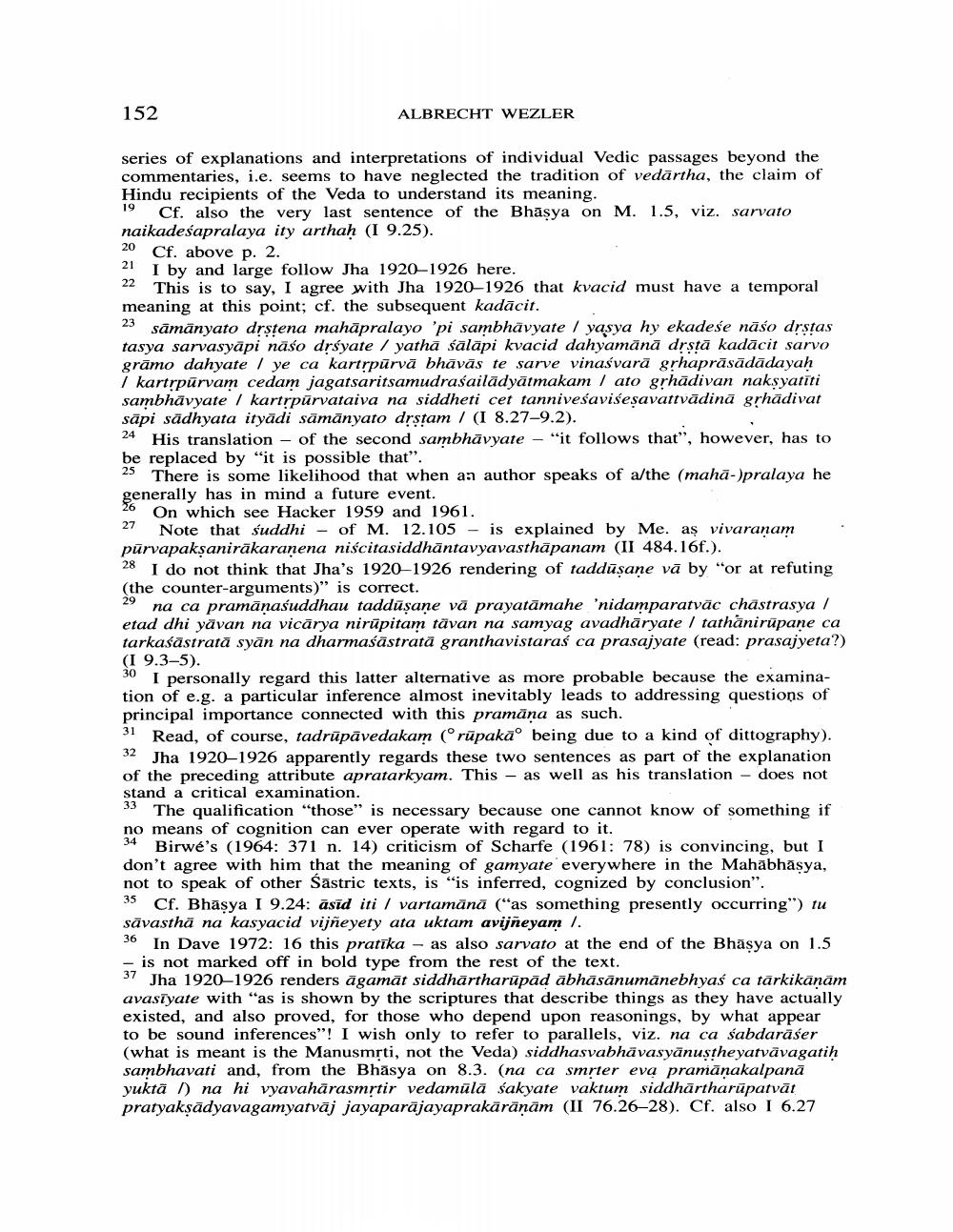________________
152
ALBRECHT WEZLER
series of explanations and interpretations of individual Vedic passages beyond the commentaries, i.e. seems to have neglected the tradition of vedārtha, the claim of Hindu recipients of the Veda to understand its meaning. 19 Cf. also the very last sentence of the Bhasya on M. 1.5, viz. sarvato naikadesapralaya ity arthah (1 9.25). 20 Cf. above p. 2. 21 I by and large follow Jha 1920–1926 here. 22 This is to say, I agree with Jha 1920–1926 that kvacid must have a temporal meaning at this point; cf. the subsequent kadācit. 23 sāmānyato drstena mahāpralayo 'pi sambhavyate / yasya hy ekadese nāśo drstas tasya sarvasyäpi näśo drsyate / yathā salapi kvacid dahyamānā drstā kadācit sarvo grāmo dahyate / ye ca kartrpūrvā bhāvās te sarve vinasvarā grhaprāsādādayah 1 kartrpūrvam cedam jagatsaritsamudraśailädyātmakam / ato grhādivan naksyatīti sambhāvyate / kartrpūrvataiva na siddheti cet tanniveśavisesavattvādinā grhādivat sāpi sädhyata ityādi sāmānyato drstam / (1 8.27-9.2). 24 His translation – of the second sambhāvyate - "it follows that", however, has to be replaced by "it is possible that". 25 There is some likelihood that when an author speaks of a/the (mahā-)pralaya he generally has in mind a future event. 26 On which see Hacker 1959 and 1961. 27 Note that suddhi - of M. 12.105 - is explained by Me. as vivaranam pūrvapakşaniräkaranena niścitasiddhäntavyavasthāpanam (II 484.16f.). 28 I do not think that Jha's 1920-1926 rendering of taddūsane vā by "or at refuting (the counter-arguments)" is correct. 29 na ca pramānasuddhau taddüşane vā prayatāmahe 'nidamparatvāc chăstrasya / etad dhi yāvan na vicārya nirūpitam tāvan na samyag avadhāryate / tathānirüpane ca tarkaśāstratā syān na dharmaśāstrată granthavistaraś ca prasajyate (read: prasajyeta?) (1 9.3-5). 30 I personally regard this latter alternative as more probable because the examination of e.g. a particular inference almost inevitably leads to addressing questions of principal importance connected with this pramāna as such. 31 Read, of course, tadrūpāvedakam (rūpakā° being due to a kind of dittography). 32 Jha 1920–1926 apparently regards these two sentences as part of the explanation of the preceding attribute apratarkyam. This - as well as his translation - does not stand a critical examination. 33 The qualification "those" is necessary because one cannot know of something if no means of cognition can ever operate with regard to it. 34 Birwé's (1964: 371 n. 14) criticism of Scharfe (1961: 78) is convincing, but I don't agree with him that the meaning of gamyate everywhere in the Mahābhāsya, not to speak of other Sastric texts, is is inferred, cognized by conclusion". 35 CE. Bhasya I 9.24: āsīd iti / vartamānā (“as something presently occurring) tu sävasthä na kasyacid vijñeyety ata uktam avijñeyam 1. 36 In Dave 1972: 16 this pratika - as also sarvato at the end of the Bhāsya on 1.5 - is not marked off in bold type from the rest of the text. 37 Jha 1920–1926 renders āgamāt siddhārtharūpād ābhāsānumānebhyas ca tärkikānām avasīyate with "as is shown by the scriptures that describe things as they have actually existed, and also proved, for those who depend upon reasonings, by what appear to be sound inferences"! I wish only to refer to parallels, viz. na ca sabdarāśer (what is meant is the Manusmrti, not the Veda) siddhasvabhāvasyānustheyatvāvagatih sambhavati and, from the Bhäsya on 8.3. (na ca smrter eva pramānakalpanā yuktā I) na hi vyavahārasmrtir vedamülā sakyate vaktum siddhārtharüpatvāt pratyakşādyavagamyatvāj jayaparājayaprakārāņām (II 76.26-28). Cf. also I 6.27




